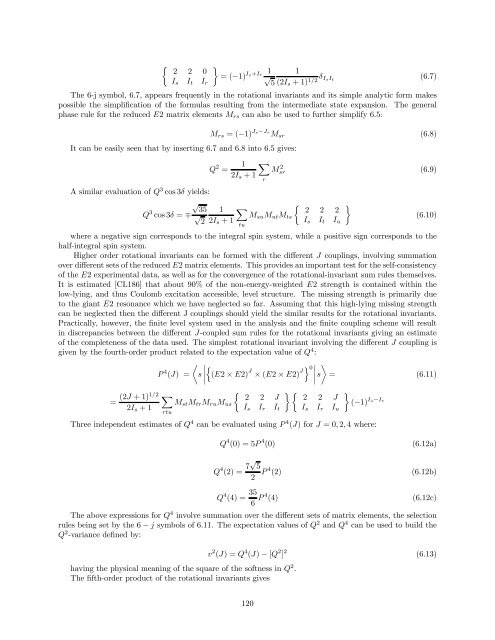coulomb excitation data analysis codes; gosia 2007 - Physics and ...
coulomb excitation data analysis codes; gosia 2007 - Physics and ...
coulomb excitation data analysis codes; gosia 2007 - Physics and ...
Create successful ePaper yourself
Turn your PDF publications into a flip-book with our unique Google optimized e-Paper software.
½ ¾2 2 0=(−1) 1 1I s I t I Is+Ir √r 5 (2I s +1) δ 1/2 I s I t(6.7)The 6-j symbol, 6.7, appears frequently in the rotational invariants <strong>and</strong> its simple analytic form makespossible the simplification of the formulas resulting from the intermediate state expansion. The generalphase rule for the reduced E2 matrix elements M rs can also be used to further simplify 6.5:It can be easily seen that by inserting 6.7 <strong>and</strong> 6.8 into 6.5 gives:M rs =(−1) Js−Jr M sr (6.8)Q 2 =12I s +1tuXMsr 2 (6.9)A similar evaluation of Q 3 cos 3δ yields:√35Q 3 1 X½ ¾2 2 2cos 3δ = ∓ √ M su M ut M ts2 2I s +1I s I t I ur(6.10)where a negative sign corresponds to the integral spin system, while a positive sign corresponds to thehalf-integral spin system.Higher order rotational invariants can be formed with the different J couplings, involving summationover different sets of the reduced E2 matrix elements. This provides an important test for the self-consistencyof the E2 experimental <strong>data</strong>, as well as for the convergence of the rotational-invariant sum rules themselves.It is estimated [CL186] that about 90% of the non-energy-weighted E2 strength is contained within thelow-lying, <strong>and</strong> thus Coulomb <strong>excitation</strong> accessible, level structure. The missing strength is primarily dueto the giant E2 resonance which we have neglected so far. Assuming that this high-lying missing strengthcan be neglected then the different J couplings should yield the similar results for the rotational invariants.Practically, however, the finite level system used in the <strong>analysis</strong> <strong>and</strong> the finite coupling scheme will resultin discrepancies between the different J-coupled sum rules for the rotational invariants giving an estimateof the completeness of the <strong>data</strong> used. The simplest rotational invariant involving the different J coupling isgiven by the fourth-order product related to the expectation value of Q 4 :¿nP 4 (J) = s¯ (E2 × E2) J × (E2 × E2) Jo À0¯¯¯¯ s = (6.11)=(2J +1)1/22I s +1Xrtu½ ¾½ ¾2 2 J 2 2 JM st M tr M ru M us (−1)I s I r I t I s I r I Is−IruThree independent estimates of Q 4 can be evaluated using P 4 (J) for J =0, 2, 4 where:Q 4 (0) = 5P 4 (0)(6.12a)Q 4 (2) = 7√ 52 P 4 (2) (6.12b)Q 4 (4) = 35 6 P 4 (4)(6.12c)The above expressions for Q 4 involve summation over the different sets of matrix elements, the selectionrules being set by the 6 − j symbols of 6.11. The expectation values of Q 2 <strong>and</strong> Q 4 canbeusedtobuildtheQ 2 -variance defined by:having the physical meaning of the square of the softness in Q 2 .The fifth-order product of the rotational invariants givesv 2 (J) =Q 4 (J) − [Q 2 ] 2 (6.13)120
















